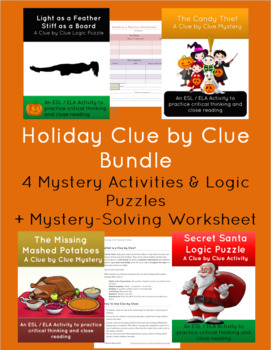Holiday Mysteries and Puzzles Bundle: Four Critical Thinking Activities
- Zip

Products in this Bundle (12)
showing 1-5 of 12 products
Bonus
Description
This bundle contains all of my holiday clue by clue activities. These activities have students practicing critical thinking, logic, reasoning, and reading strategies as they solve a fun mystery or logic puzzle. They work for students of all ages and make a great group activity to get students talking and expressing opinions. But they can be done as individual activities. This bundle includes 6 mysteries (for Valentines Day, Halloween, Thanksgiving, and Christmas), each in PDF format, perfect for printing and using in class, as well as PowerPoint. That's 8 resources that hit all the major holidays!
What is a Clue by Clue Mystery?
A great warm-up, critical thinking game, conversation starter, filler, or a time killer for early finishers. Students in pairs or small groups are given a short mystery to solve—whodunit or how did they do it or why. They have to figure it out by reading a series of clues, one at a time. As they receive each clue, they speculate on its significance, what it tells them about the situation, and how it fits with the previous clues.
Once they have received all the clues, they have enough information to figure it out! This one will definitely get your students talking!
While students are solving the mysteries they are also developing their spoken language skills, using language such as:
* Modal verbs of speculation: She must have forgotten her keys, It could have been the butler
* Opinion language: I think...., I’m positive..., I’m not sure...
* Hedging: It’s possible, probably, maybe, it’s not impossible.
* Conclusions: That means that...
* Emphasis: There’s no way that...
* Hypotheticals: What if he didn’t do it, If he was at the movies, he couldn’t have done it.
They are also a lot of fun!
Teacher Notes on how to use them are included with hints and the solution. Many also include discussion questions or other extension ideas.
Enjoy this? Check out my entire Mystery Section with more clue by clues in different formats. I also have activities to help students write their own mysteries and more! You can also check out my Holiday Activities with more resources for Halloween, Thanksgiving, Christmas, New Year's and more.
And please leave a review. It helps others find this resource and gives me valuable feedback when creating new ones!





